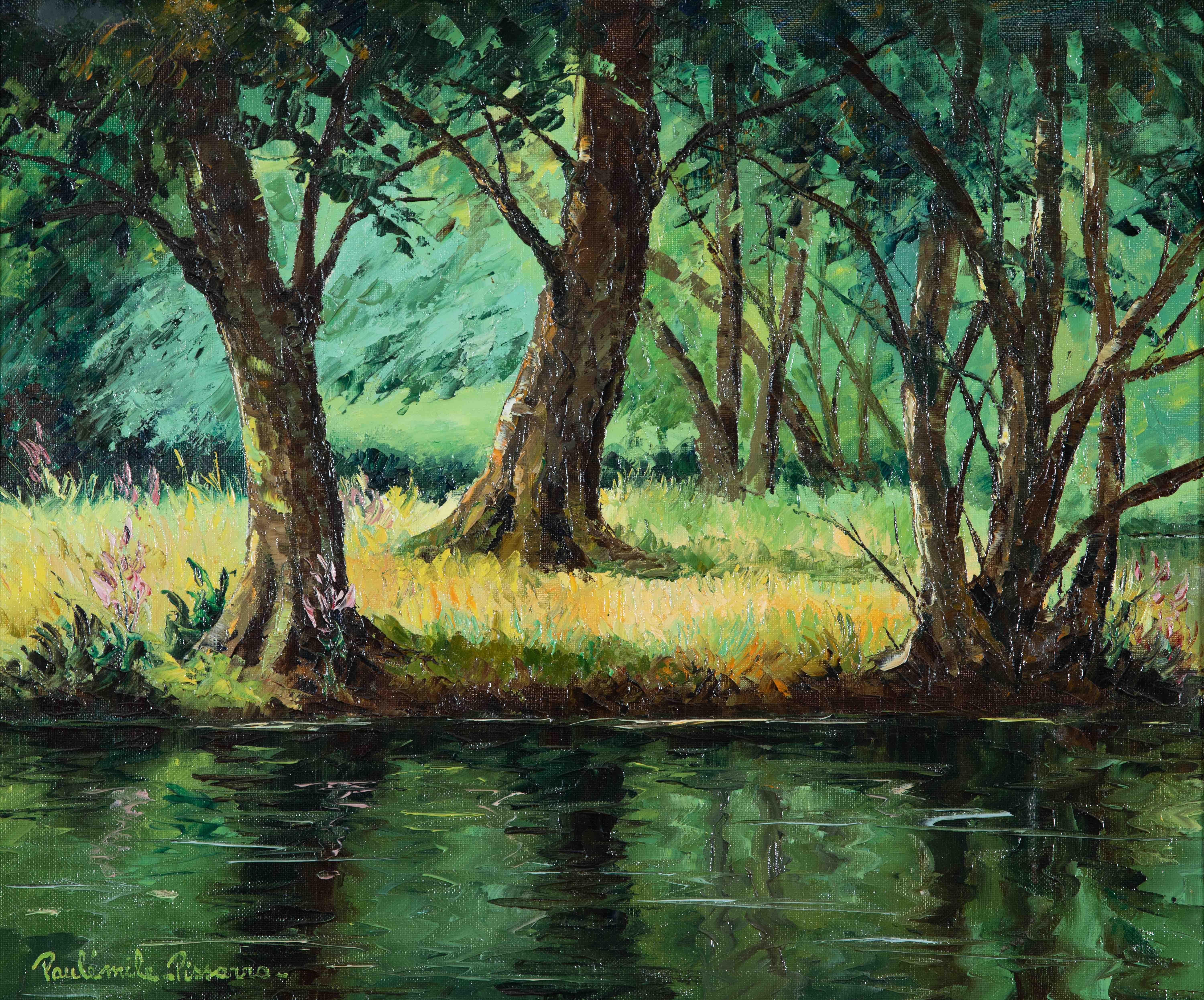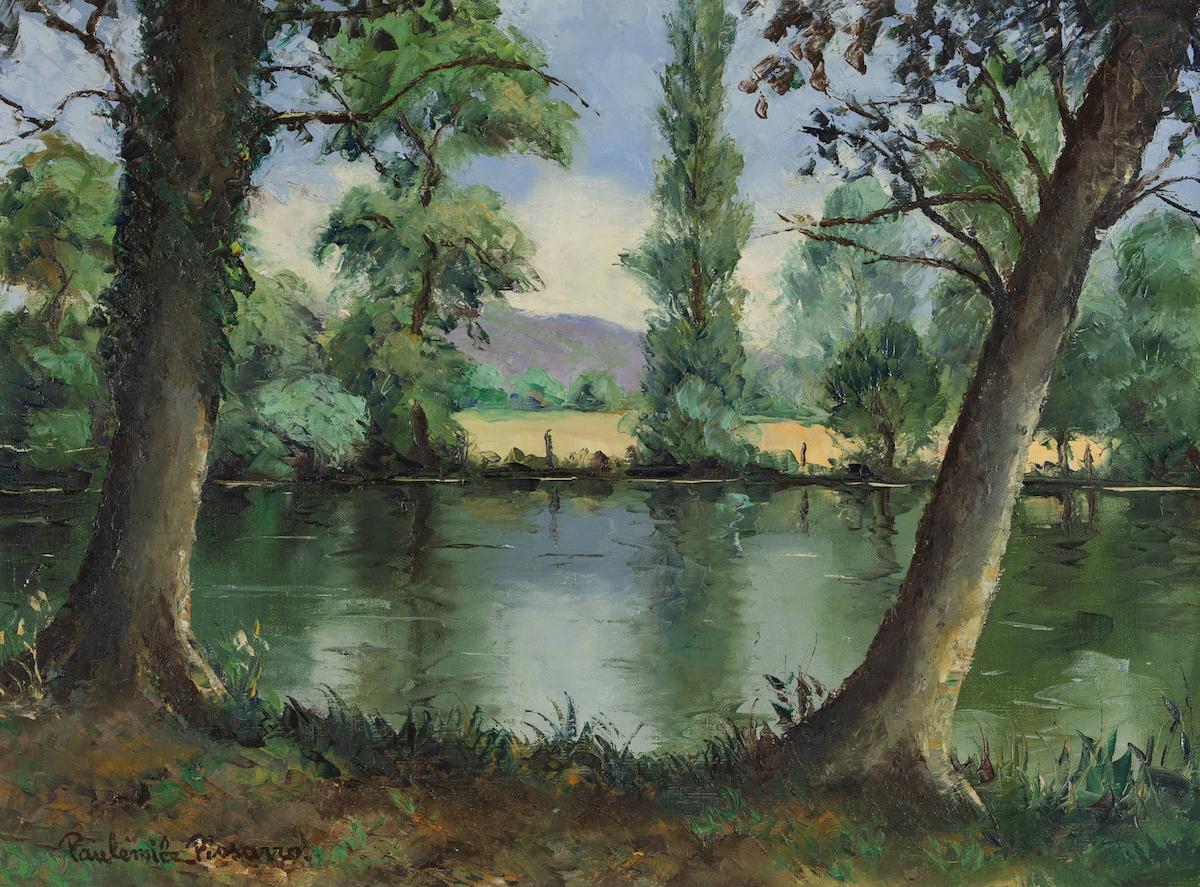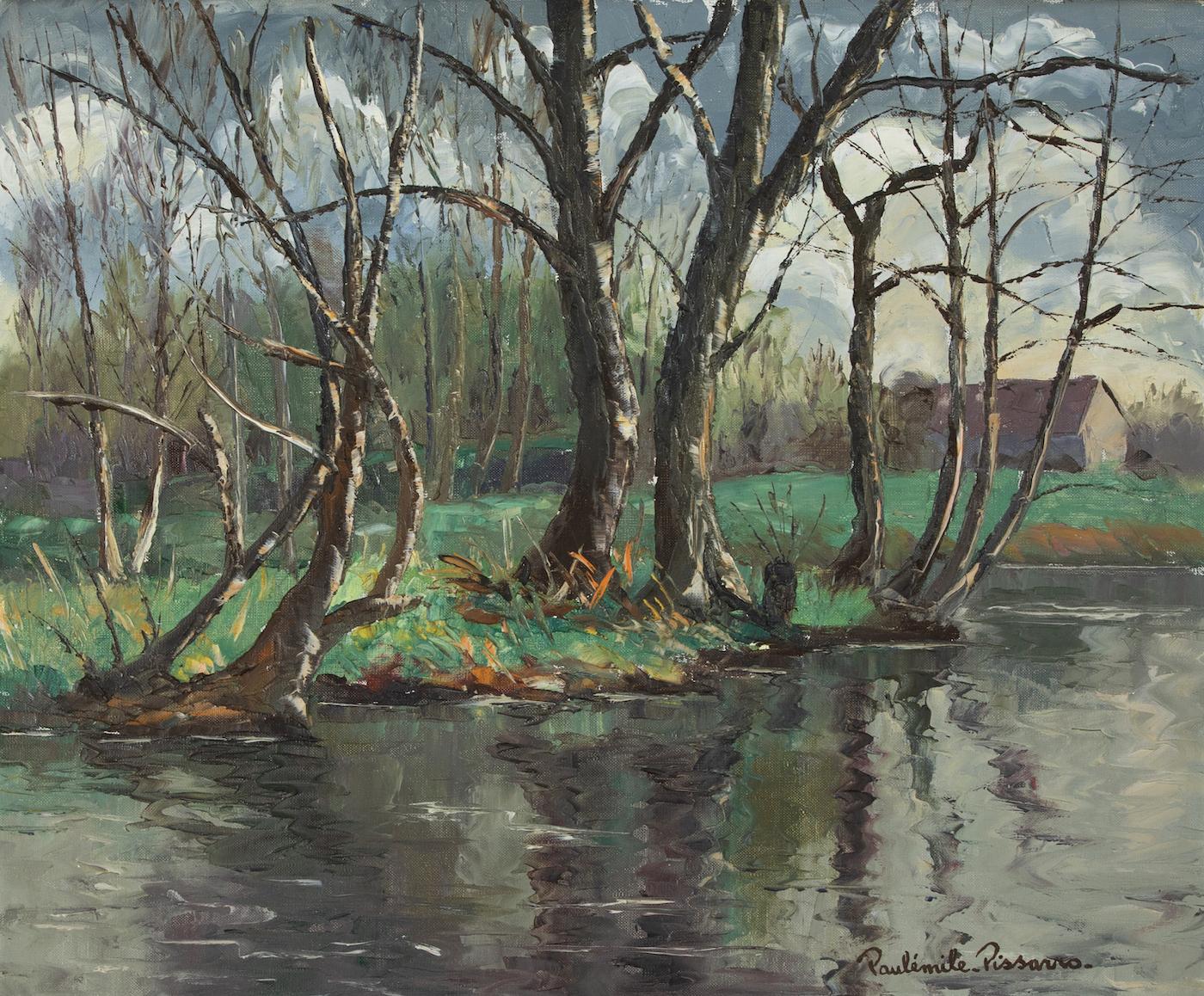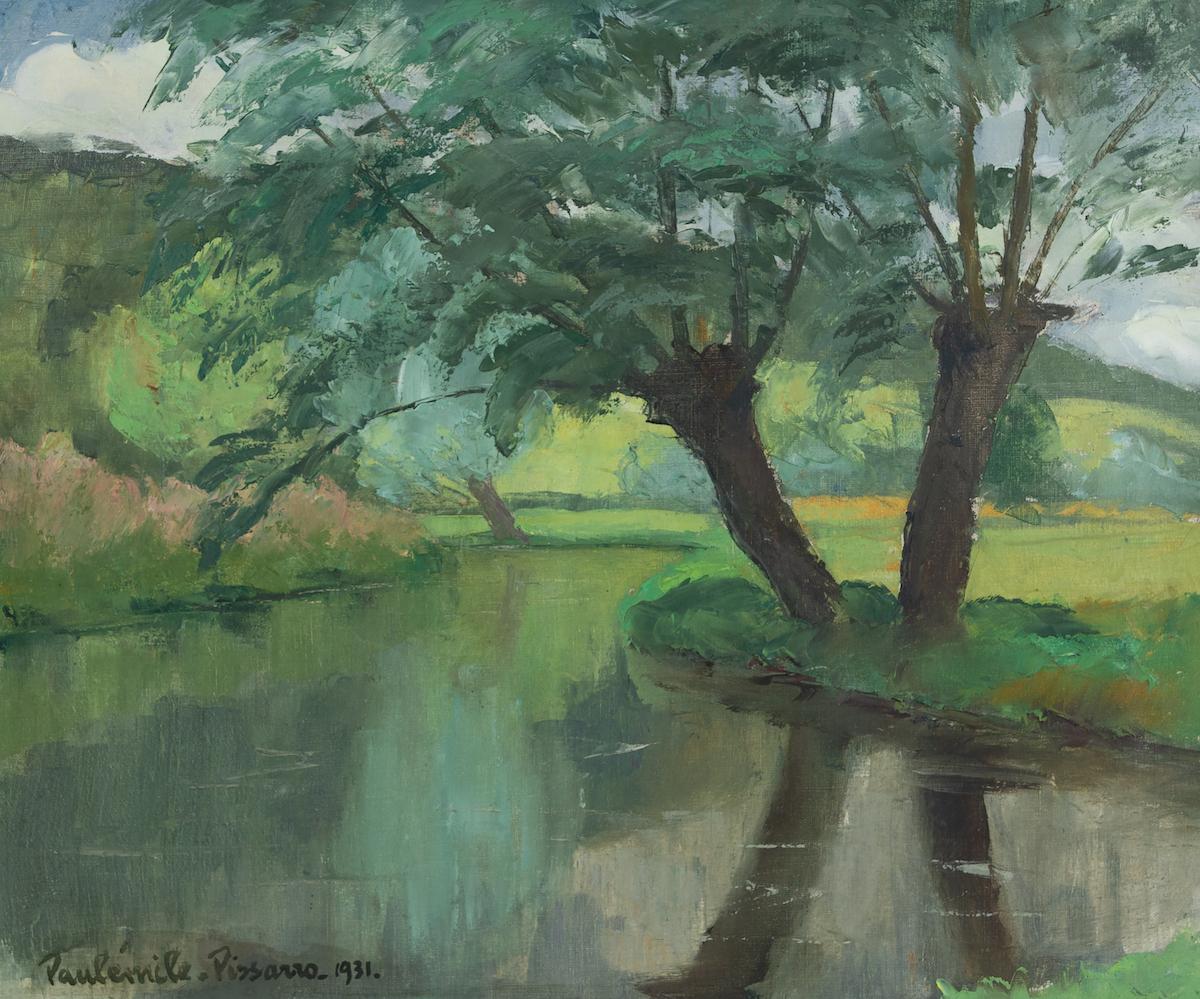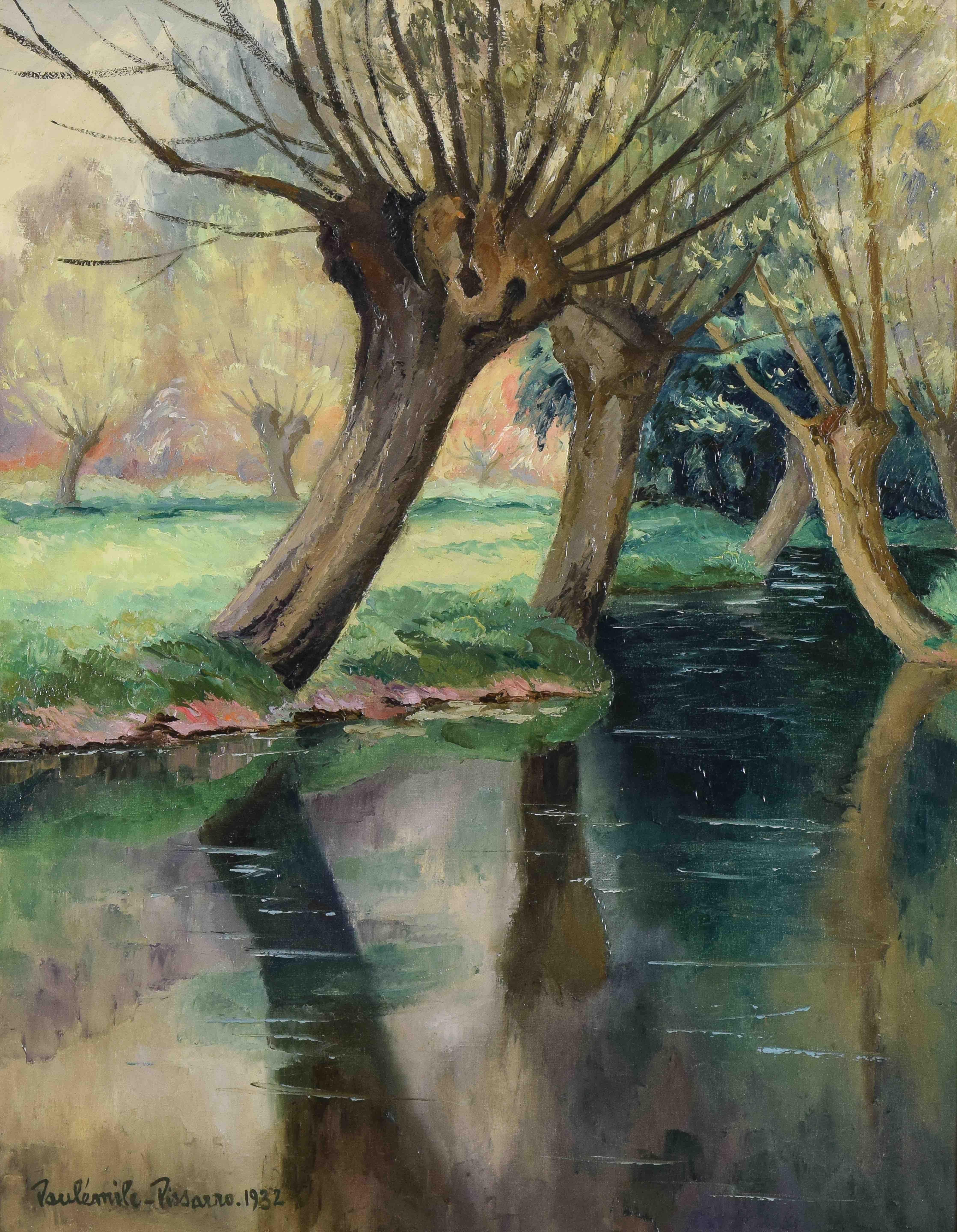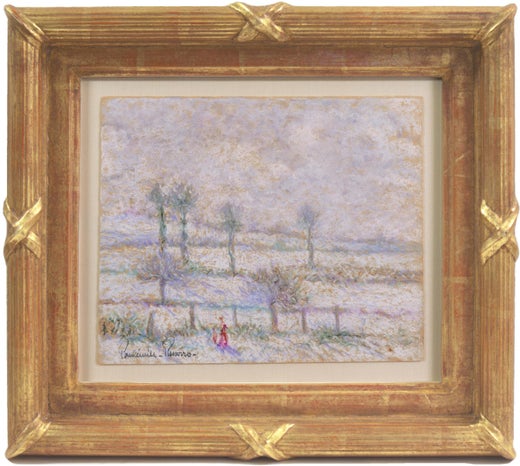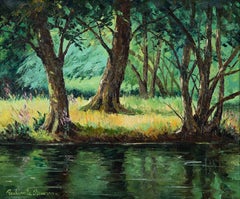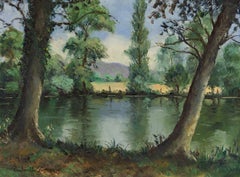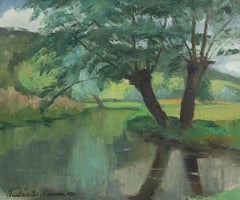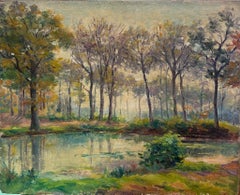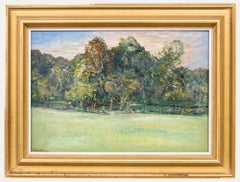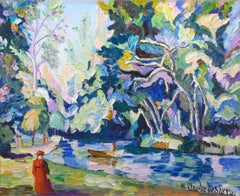Items Similar to Les Bords de l’Orne au Soleil Couchant by Paulémile Pissarro -Landscape painting
Want more images or videos?
Request additional images or videos from the seller
1 of 12
Paul Emile PissarroLes Bords de l’Orne au Soleil Couchant by Paulémile Pissarro -Landscape painting1950s
1950s
$17,500
£13,195.04
€15,262
CA$24,758.88
A$26,992.59
CHF 14,262.36
MX$331,945.37
NOK 177,341.02
SEK 166,943.07
DKK 113,933.60
About the Item
*PLEASE NOTE UK BUYERS WILL ONLY PAY 5% VAT ON THIS PURCHASE.
Les Bords de l’Orne au Soleil Couchant by Paulémile Pissarro (1884-1972)
Oil on canvas
54 x 65 cm (21 ¹/₄ x 25 ⁵/₈ inches)
Signed lower left, Paulémile Pissarro.
Executed in the 1950s
This work is accompanied by a certificate of authenticity by Lélia Pissarro and will be included in the forthcoming catalogue raisonné.
Provenance: Private collection, Austria
Artist biography:
Paulémile Pissarro, Camille Pissarro’s youngest son, was born in Éragny in 1884 where he was brought up within the creatively fertile environment of his family home and, encouraged by his father, began drawing at an early age. Paulémile’s godfather was Claude Monet, who became his teacher and legal guardian after Camille’s death in 1903.
In 1905 Paulémile exhibited at the Salon des Indépendants for the first time. Although his father had supported Paulémile’s desire to be an artist, his mother was eager for him to learn a more practical trade. Therefore in 1908 he put aside his artistic pursuits to work as an automobile mechanic and test-driver, then later as a lace and textile designer, allowing him only a limited time to paint. Paulémile only fully dedicated himself to painting following a letter from his brother Lucien in London, who wrote to invite him to take part in an exhibition held in London. Subsequent to the successful sale of a number of watercolours he had sent over, the young artist became inspired to leave the textile factory and pursue a career in art.
By the 1920s Paulémile had become an established Post-Impressionist artist in his own right, spending the summer months escaping from Paris on painting trips with fellow artists Kees Van Dongen, Raoul Dufy, Maurice de Vlaminck and André Dunoyer de Segonzac. In 1922 Paulémile purchased a house in Lyons-la-Forêt, a small village within the region of his hometown of Éragny and Giverny, where he moved in with his first wife Berthe Bennaiche. During this time, he developed a form of Cubism inspired by Paul Cézanne whom he dearly admired, creating some wonderful paintings of the river Eure and its surrounding villages. There he formed a close friendship with his neighbour, the famous Art Deco designer Émile-Jacques Ruhlmann, who designed a stunning Art Deco studio for Paulémile adjacent to his house.
In 1930 he visited and fell in love with the Swiss Normandy area in the Calvados region, in particular the River Orne which runs through the valley adjacent to the villages of Clécy and St. Remy. The combination of rolling hills, bold meadows and the calm river weaving its way through the landscape offered Paulémile a new burst of inspiration. With his second wife Yvonne Beaupel, Paulémile eventually moved to Clécy in 1935, where he would remain for the rest of his life. Of their three children, both H. Claude and Yvon also became artists.
With his house backing on to the river Orne, Paulémile developed a new way of working using a boat as a floating studio, where he spent countless days painting the calm waters from between the riverbanks. Here the influence of his godfather Claude Monet became apparent, particularly in Paulémile’s depiction of water, which was revolutionised by the Impressionist icon. He also applied Monet’s lessons in horticulture to the creation of an abundant garden, offering him many more motifs for his new paintings. Alongside these river landscapes, he also painted the neighbouring hay fields, various snow scenes, some interiors and still lives. The most ambitious work in his oeuvre was a fresco painted on all four walls of his own dining room, depicting the adjacent river in which he includes family members, neighbours and friends.
In 1967 Paulémile had his first one-man show in the United States at Wally Findlay Galleries in New York. This led to widespread recognition and a degree of professional success that few Pissarro artists knew during their lifetime. Since his death in 1972, Paulémile remains one of the best known of Camille’s sons.
- Creator:Paul Emile Pissarro (1884-1972, French)
- Creation Year:1950s
- Dimensions:Height: 21.26 in (54 cm)Width: 25.6 in (65 cm)
- Medium:
- Period:
- Condition:
- Gallery Location:London, GB
- Reference Number:1stDibs: LU261214059232
Paul Emile Pissarro
Paul Émile Pissarro (1884–1972) was a French painter and the youngest son of the renowned Impressionist Camille Pissarro. Known as “Paulémile,” he grew up surrounded by artistic innovation and was deeply influenced by his father’s Impressionist style and philosophy. However, he later developed his own artistic voice, primarily within the Post-Impressionist and Fauvist movements. Paulémile’s early artistic training came from his father and contemporaries like Claude Monet and Pierre-Auguste Renoir. This exposure instilled in him a love for plein air painting and the vibrant use of color, traits that became hallmarks of his work. His depictions of rural landscapes, especially those of Normandy and the French countryside, reveal his sensitivity to light, texture, and seasonal changes. While initially working in his family’s tradition, Paulémile gradually incorporated Fauvist influences, embracing bolder, more expressive color palettes. His style also reflected the growing trend toward modernism in the early 20th century. His paintings exhibit a harmony between Impressionist principles and more dynamic, emotive compositions. In addition to painting, Paulémile collaborated with the art dealer Paul Durand-Ruel, whose support solidified his career. Despite his father’s towering legacy, Paulémile maintained a consistent artistic output, earning recognition in his own right through exhibitions in Paris and abroad. Paul Émile Pissarro’s contributions lie in his ability to bridge Impressionism with early modernist sensibilities, ensuring the vitality of landscape painting well into the 20th century. His work continues to be celebrated for its vibrancy and lyrical quality.
About the Seller
5.0
Recognized Seller
These prestigious sellers are industry leaders and represent the highest echelon for item quality and design.
Gold Seller
Premium sellers maintaining a 4.3+ rating and 24-hour response times
Established in 1964
1stDibs seller since 2015
104 sales on 1stDibs
Typical response time: 2 hours
Associations
Society Of London Art Dealers
- ShippingRetrieving quote...Shipping from: London, United Kingdom
- Return Policy
Authenticity Guarantee
In the unlikely event there’s an issue with an item’s authenticity, contact us within 1 year for a full refund. DetailsMoney-Back Guarantee
If your item is not as described, is damaged in transit, or does not arrive, contact us within 7 days for a full refund. Details24-Hour Cancellation
You have a 24-hour grace period in which to reconsider your purchase, with no questions asked.Vetted Professional Sellers
Our world-class sellers must adhere to strict standards for service and quality, maintaining the integrity of our listings.Price-Match Guarantee
If you find that a seller listed the same item for a lower price elsewhere, we’ll match it.Trusted Global Delivery
Our best-in-class carrier network provides specialized shipping options worldwide, including custom delivery.More From This Seller
View AllBord de Riviere Soleil Couchant by Paulémile Pissarro - Landscape, oil painting
By Paul Emile Pissarro
Located in London, GB
Bord de Riviere Soleil Couchant by Paulémile Pissarro (1884-1972)
Oil on canvas
46 x 55 cm (18 ¹/₈ x 21 ⁵/₈ inches)
Signed lower left, Paulémile Pissarro
Signed and titled on the rev...
Category
20th Century Post-Impressionist Landscape Paintings
Materials
Canvas, Oil
Bord de l'Orne by Paulémile Pissarro - Post-Impressionist oil river scene
By Paul Emile Pissarro
Located in London, GB
*UK BUYERS WILL PAY AN ADDITIONAL 20% VAT ON TOP OF THE ABOVE PRICE
Bord de l'Orne by Paulémile Pissarro (1884-1972)
Oil on canvas
46 x 61 cm (18 ¹/₈ x 24 inches)
Signed lower left...
Category
1950s Post-Impressionist Landscape Paintings
Materials
Canvas, Oil
Les Iles à Cantepie by Paulémile Pissarro - River scene painting
By Paul Emile Pissarro
Located in London, GB
*UK BUYERS WILL PAY AN ADDITIONAL 20% VAT ON TOP OF THE ABOVE PRICE
Les Iles à Cantepie by Paulémile Pissarro (1884-1972)
Oil on canvas
54 x 65 cm (21 ¹/₄ x 25 ⁵/₈ inches)
Signed l...
Category
1950s Post-Impressionist Figurative Paintings
Materials
Canvas, Oil
Rivière et Saules by Paulémile Pissarro - Post-Impressionist river scene
By Paul Emile Pissarro
Located in London, GB
Rivière et Saules by Paulémile Pissarro (1884-1972)
Oil on canvas
46.1 x 55.2 cm (18 ¹/₈ x 21 ³/₄ inches)
Signed and dated lower left Paulémile-Pissarro-1931
Titled on the reverse
P...
Category
1930s Post-Impressionist Landscape Paintings
Materials
Canvas, Oil
Rivière Saulaie à Lyons-la-Forêt, Eure by Paulémile Pissarro - Oil painting
By Paul Emile Pissarro
Located in London, GB
Rivière Saulaie à Lyons-la-Forêt, Eure by Paulémile Pissarro (1884-1972)
Oil on canvas
60 x 73 cm (23 ⁵/₈ x 28 ³/₄ inches)
Signed lower left, Paulémile - Pissarro.
Signed and titled...
Category
1920s Impressionist Landscape Paintings
Materials
Canvas, Oil
La Rivière by PAULÉMILE PISSARRO - Post Impressionist Landscape Painting, River
By Paul Emile Pissarro
Located in London, GB
*UK BUYERS WILL PAY AN ADDITIONAL 20% VAT ON TOP OF THE ABOVE PRICE
La Rivière (The River) by PAULÉMILE PISSARRO (1884-1972)
Oil on canvas
92 x 73 cm (36 1⁄4 x 28 3⁄4 inches)
Signed...
Category
1930s Post-Impressionist Landscape Paintings
Materials
Oil, Canvas
You May Also Like
Mid 20th Century French Impressionist Oil Dappled Light Golden River Landscape
Located in Cirencester, Gloucestershire
Dappled Light
signed by Regine David (female French artist, 1910-2018)
dated 1945
oil painting on board, unframed
measures: 13 x 16 inches
condition: the painting is in very sound an...
Category
Mid-20th Century Post-Impressionist Landscape Paintings
Materials
Oil
Georges Eugene Delhomme (1904-1989) - 20th Century Oil, Sunset at Bry-sur-Marne
Located in Corsham, GB
This landscape painting depicts a serene pastoral scene featuring a verdant meadow in the foreground that stretches toward a dense grove of mature trees under a soft sunset sky.
Sig...
Category
20th Century Landscape Paintings
Materials
Oil
Normandy : River and Mountains - Original oil on canvas, Handsigned
By Paul Emile Pissarro
Located in Paris, IDF
Paul Emile Pissarro (1884-1972)
Normandy: Mountain Landscape with a River, 1955
Oil on canvas
Signed lower left
Countersigned on the back
Title and dated on the back
On canvas 20F o...
Category
Mid-20th Century Post-Impressionist Landscape Paintings
Materials
Oil
La petite île by H. Claude Pissarro
By Hughes Claude Pissarro
Located in New Orleans, LA
Hugues Claude Pissarro
b.1935 French
La petite île
(The Little Island)
Signed “H. Claude Pissarro” (lower right)
Oil on canvas
In this composition, French artist H. Claude Pissar...
Category
20th Century Post-Impressionist Landscape Paintings
Materials
Canvas, Oil
Paysage Arboré Wooded Landscape Framed Provincial Oil Painting Flanders Artist
By Henri Joseph Pauwels
Located in Sutton Poyntz, Dorset
Henri Joseph Pauwels.
Belgian ( b.1903 - d.1983 ).
Paysage Arboré. (Wooded Landscape). 1966.
Oil On Artist’s Board.
Signed & Dated Lower Left.
Image size 14.2 inches x 17.3 inches ( 36cm x 44cm ).
Frame size 21.1 inches x 24.6 inches ( 53.5cm x 62.5cm ).
Available for sale; this original oil painting is by the Flanders artist Henri Joseph Pauwels and is dated 1966.
The painting is presented and supplied in a sympathetic contemporary replacement frame (which is shown in these photographs).
The painted surface is entirely in its original untouched condition. No restoration, cleaning or conservation has been performed on the artwork.
This vintage painting is in a good sound decorative condition. It wants for nothing and is supplied ready to hang and display.
The painting is signed and dated lower left.
Previously with Galerie Jean-Marr, Le Havre, France.
Henri Joseph Pauwels was a notable twentieth century Flemish painter, rooted in Impressionist traditions. He was born on 16 December 1903 in Sleidinge near Antwerp. He died on 12 March 1983 in Beveren-Waas.
Pauwels trained academically in Paris, then in private studios in Antwerp. His early works demonstrate his academic training, but he was heavily influenced by Impressionism and his later work has a more vibrant palette and airy, loose brushwork. He was known for his plein air technique, as shown in this piece. Pauwels exhibited widely, mainly in Paris, Brussels and Amsterdam and was successful both before and after WWII. Some of his works are held in public collections, including the Ghent Museum.
His works were highly collectable amongst his contemporaries in Belgium, France and the Netherlands. He is known for a range of genres but is best known for his large canvases of romantic landscapes and country life. He also painted harbour scenes and some still life. His works remain collectable for their optimistic, poetic and nostalgic views of wholesome country life.
© Big Sky Fine Art
Discover Paysage Arboré, an original 1966 oil painting on board by Belgian artist Henri Joseph Pauwels (1903–1983). This tranquil landscape captures a lush, tree-lined riverbank rendered in rich Impressionist brushwork and a naturalistic palette of greens, browns, and blues. Signed and dated in the lower left, this collectible work showcases Pauwels’ mastery in capturing light, texture, and atmosphere in the Flemish countryside. A fine example of mid-20th century Belgian landscape painting...
Category
Mid-20th Century Post-Impressionist Landscape Paintings
Materials
Oil
Antique French Impressionist Oil Tranquil Riverbank Scene Luminous Landscape
Located in Cirencester, Gloucestershire
Tranquil Riverbank Scene
first half 20th century
Charles Marvin - Sauvaigo ( 1881 - 1970)
signed oil on canvas, framed
Canvas: 18 x 21.5 inches
Provenance: private collection, Franc...
Category
Mid-20th Century Impressionist Landscape Paintings
Materials
Oil
More Ways To Browse
Pissarro Paul Emile
Italy Cityscapes
Old Amsterdam
Pond Surround
1907 Frames
Alpine Oil Paintings
Church Steeple
Crashing Waves Painting
Framed Waterfall Paintings
Frederick Fine Art
Gerald Peters
Hudson River Painters
Irish Impressionist
Israeli Landscape Paintings
Jacques Oil On Canvas
Maritime Boat
Art Birch Trees
Blossom Time
